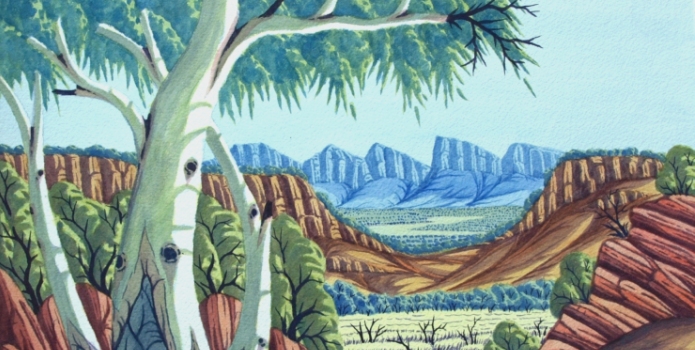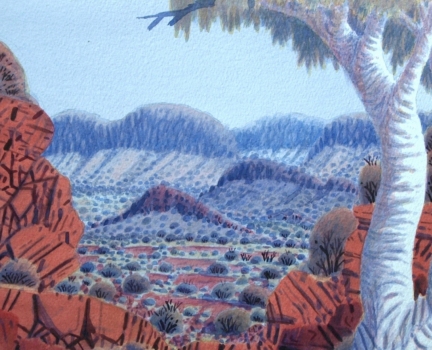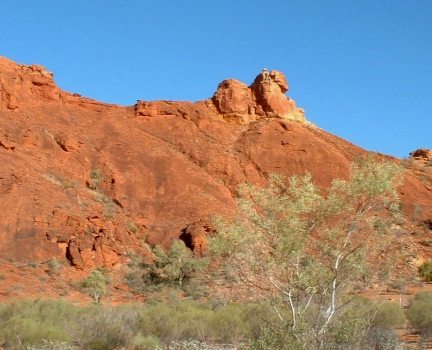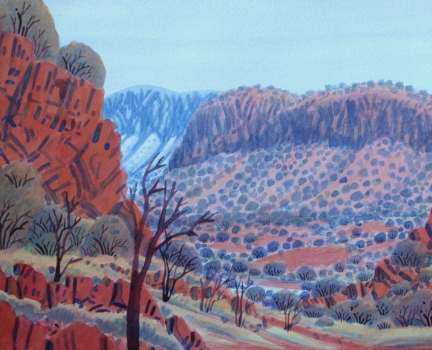Albert Namatjira & the Hermannsburg School
For many Australians whose exposure to Aboriginal art was prior to the 1970s, the name of Albert Namatjira (1902-1959) is likely to nominate the first famous Aboriginal artist they would recognise. Albert Namatjira held his first exhibition in Melbourne in 1938 and his fine watercolour paintings of the dramatic Australian landscapes around his home community at Hermannsburg created great interest and instant sales success.
Albert Namatjira first saw the watercolour paintings in 1934 of two artists, Rex Battarbee and John Gardner, who were painting in Central Australia at the time. Namatjira was immediately interested in learning about the medium and his persistence paid off - Rex Battarbee took him on his next painting expedition in 1936. With Albert as the guide, they visited some spectacular locations around the Western MacDonnell Ranges in the vicinity of Albert’s homelands near Hermannsburg. These exceptional landscapes were immortalised in the paintings that Albert Namatjira created, and for Australians, who had rarely seen such country, the colour and the light in his desert paintings was a revelation.
Albert Namatjira’s reputation grew during the 1940s and 1950s and he met with visiting dignitaries from around the world, including the Queen of England. Albert’s exhibitions continued to sell extremely well and Albert shared his skills with other countrymen, going on to inspire a whole generation of artists. Among the first to learn from Albert was Walter Ebatarinja and the Pareroultja Brothers – Edwin, Otto and Reuben – who had a totemic kinship bond to Albert, and then Albert’s five sons – Enos, Oscar, Ewald, Keith and Maurice.
By combining their deep ancestral connection to their Arrente country and their drawing skills in representing the immensity of the country and the changing effects of the light, Albert Namatjira and the artists that he inspired established a powerful school of painting that had a major impact across Australia. The recognisable Aboriginal qualities of the artworks provided a unique view of the land and created some of the first bridges between Aboriginal and western cultures, which were later reinforced by other forms of desert art.
Rex Battarbee maintained his close association with Albert Namatjira and the artists group, and throughout the 1940s and 1950s exhibited and promoted the artists’ work. By the 1960s Albert Namatjira was a household name. But the end of Albert’s life was marred by cultural difficulties and contradictions. Living in Alice Springs and granted full citizen rights, Albert was in a position that none of his countrymen shared. His cultural obligations to his clan group put him in an impossible position – he could not have privileges and assets without sharing them with his fellow Arrente kinsmen. In this era Aboriginal people did not possess citizen rights and could not obtain alcohol, and Albert who could do so, was under pressure to provide for his countrymen. In following his cultural obligations Albert was breaking the law, and was imprisoned. This largely broke his spirit and Albert Namatjira retired back into his homelands and died at the age of 57.
Albert Namatjira’s legacy continues. There are still grandchildren of the artist and many other descendants who keep the Hermannsburg tradition alive, exhibiting and selling beautiful works, all based in Albert’s traditional lands of the West MacDonnell Ranges. Albert Namatjira remains a famous name more than fifty years after his death, and his paintings command significant prices when they come up at auction.
Links:





